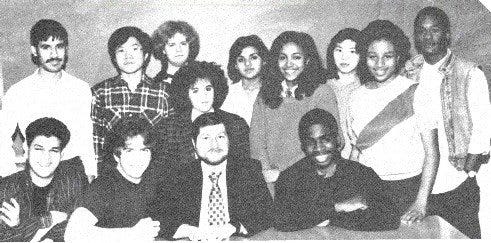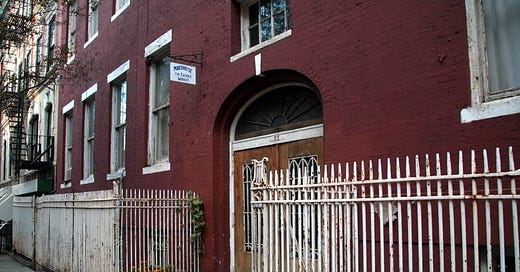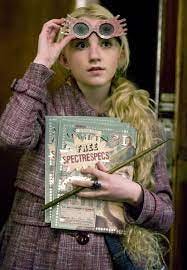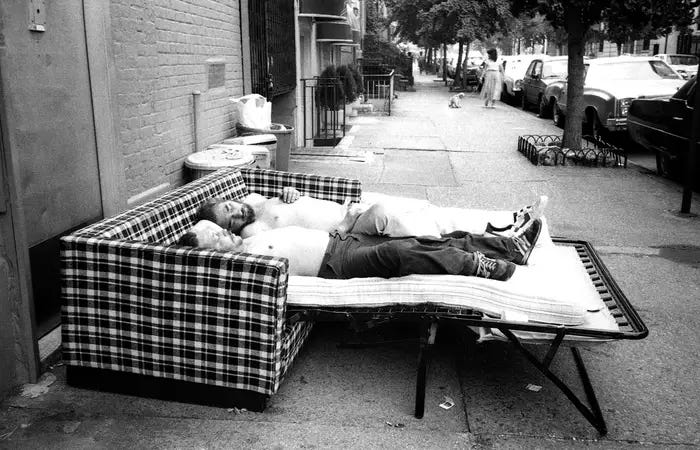Hello again, my friends. Now that I’ve reviewed “Soul Doctor,” the movie about the friendship between singer Nina Simone and Reb Shlomo Carlebach, I want to tell my own story with Reb Shlomo. Really, it’s nothing less than the start of the spiritual journey that continues to define my life. I’ve written parts of it before as an attempt at memoir, so if I shift in tone from essay to storytelling, understand that I’m melding together several previous drafts. Memoir-writing is hard – both emotionally and conceptually. You’d be surprised at how challenging it is to organize the events of your life into a coherent narrative. This will probably take several posts.
Since Reb Shlomo was “the soul doctor,” it seems fitting that I cite a teaching from the Talmud: “G-d prepares the cure before sending the disease.1” The meaning of the teaching is fairly straightforward. The solutions to our problems are given to us before we’re confronted with the problems themselves. It may take ingenuity to recognize how, but the tools are at hand in the circumstances of our lives.
The Talmud makes this observation regarding the Biblical Book of Esther. Because Esther was Queen of Persia, she was in a position to use her influence with the king to save the Jewish people from annihilation. But her forced marriage to the king occurred five years before the decree against the Jews. She was the solution put in place before the problem arose.
Mordechai the Sage tells her as much. At first, Esther was reluctant to make her appeal to the king. If he saw her request as brazen, he could have had her killed, as he did with her predecessor, Queen Vashti. When discussing her options with Mordechai, he said, “If you persist in keeping silent at a time like this, relief and deliverance will come to the Jews from some other place, while you and your father’s house will perish. And who knows whether it was for just such a time as this that you attained the royal position.2”
Notice that Mordechai didn’t try and convince her that all would be lost without her. She represented one possible solution, but without her intervention, “relief and deliverance will come from some other place.” Some other Jew in Persia would have the opportunity to make a similarly brave choice and save our people. The particular circumstances would have been different, but the end result would have been the same. G-d doesn’t send just one cure in advance of the disease. He builds this world with many options to tap into.
Now, most of us don’t get to do anything of historic impact like Esther, but the principle of the cure before the disease is in play in all of our lives. The prime example in mine was meeting the soul doctor himself.
I was only a high school student when I ventured into the Carlebach shul. I was a real oddball back then, not just a nerd, but socially clueless in the extreme. Imagine Luna Lovegood as a Jewish Muggle. Instead of talking everyone’s ear off about the crumple-horned snorkack, my obsessions were communism and astrology. Both of them play a role in this story.

First, astrology. Though I was as uncool as they come, I did have a tight circle of friends, and among them was a set of twins named Pat and Carol Silverberg. For Chanukah, they bought me a tear-off astrological calendar with a prediction for every day of the coming year.
I loved my calendar. I consulted it religiously. The trouble was, the predictions were phrased so vaguely, most of the time, I couldn’t figure out how to apply them. So I was pleasantly surprised one spring day when I got an unusually specific instruction: “Today would be a good day to do community service.”
Now, I could have taken that in any number of directions. There was no shortage of options. I didn’t even have to leave my school. My English teacher once recruited me to tutor an ESL student. I could have done more of that. Or I could have cleaned cages at the ASPCA. I loved animals, and I earned most of my pocket money by taking care of people’s pets when they went on vacation. None of those things even occurred to me. I was determined to volunteer at a homeless shelter.
If you’ve been to New York, then you’ve seen our problem. Grimy people who smell of dried urine, and occasionally even gangrene, push all their worldly possessions around in a shopping cart. They panhandle on the subways or just sit on a busy street with a cardboard sign explaining their troubles. Some write out their stories in a few sentences. Others limit it to a single word or phrase. “Evicted.” “Vietnam Vet.” Or just plain, “Hungry.”
As bad as things are here now, it was worse in the 80’s. That’s really when homelessness went from problem to crisis, and I don’t think that’s just the perception of someone who was first waking up to it then. It’s a known fact that a wave of federal budget cuts forced the mental hospitals to release their patients. They ended up spilling onto the streets and subways with no way to fend for themselves, other than begging. You could pass a posh place like the Plaza Hotel, watch all the fancy guests get their luggage wheeled in by white-gloved, uniformed bellhops, and then cross into Central Park where homeless people built a whole shanty town of cardboard boxes.
It was too much for my impressionable teenage heart. I felt a kinship for those people. I’d give them coins and chat with them. Sometimes I still do.
“But for the grace of G-d go I,” read the sign worn around the neck of a blind man who sold pencils opposite the 42nd Street Library.
That sign said it all. I had my own struggles with mental health, as did my late father. It could have been us out there. But for the grace of G-d, it wasn’t.
The homeless crisis politicized me. It was the reason I declared myself a communist. But when I called out for “Revolution!” all I really meant was, “This world is unfair and needs to change.”
And that is how I ended up following my daily horoscope to Mary House, a shelter in the East Village run by the Catholic Worker. It houses elderly and indigent women who are too old and weak to survive the tough, city-run shelter system.
As a Jew, I knew nothing about the Catholic Worker or its founder, Dorothy Day. Had I known, I would have seen her as a role model. She, too, considered herself a communist. She ended up abandoning it in favor of Catholicism, but instead of repudiating her former ideals of social justice, she implemented them into hands-on charitable living. I like to think she would have been pleased with what happened to this Jew in the home that her vision built.
The first task I was given was to wash industrial-sized pots. They were bigger than any dish I’d ever washed at home and awkward to maneuver. Deep inside were spots of orange grease I couldn’t reach, no matter how hard I tried. After a few hours, with my sleeves soaked through to the elbows, I received thanks and went home.
A few weeks later, my calendar gave me some wonderful news. “Today could be one of the most favorable days of the year for you.”
It was late May. The weather was perfect. It was probably the most favorable day of the year for everybody. Whoever wrote that calendar must have consulted the Farmer’s Almanac.
What would you do with the most favorable day of the year? Buy a lottery ticket? Muster up the courage to finally ask that special someone on a date? I didn’t plan mine with any such strategy. I just went back to Mary House.
Once again, I was given pots to wash, but this time, someone came along and told me I could take a break in the garden in back. Not that it was much of a garden. It was a tiny patch of grass enclosed on all sides by a chain link fence. Beyond the fence were nothing brick buildings and concrete. But still, a breath of fresh air for a building in Manhattan.
Two other women were already there. Both were in their thirties or forties. One was a chubby blonde with pink-tinted glasses. The other one had dark hair with grey streaks. She wore her shirt collar unfolded and pulled up so that it stood stiffly around her neck, as though she were shielding herself. I could tell right away that there was something a little off about her.
We introduced ourselves. I don’t remember the blonde’s name, so I’ll call her Renee. I’ll never forget the other one. Her name was Amelia.
“Do you live here?” I asked. Though they were both older than me, they were still much younger than the residents I’d already seen.
“No. I rent a studio on the block,” said Renee. “I just come to sit in the garden.”
I nodded and looked over at Amelia. She seemed a more likely candidate for a homeless shelter.
“I don’t live here either,” she said. “I live with my parents on the Lower East Side.”
A woman that age still living with her parents! It could only mean one thing: she was mentally ill and couldn’t live on her own. Sensory defensiveness, I now know, is the reason she was wearing her collar high up like that. But since mental illness was part of my family history, I knew better than to be judgmental.
“It’s not just a shelter here,” said Renee. “It’s a resource for people in the neighborhood.”
“Technically,” said Amelia, “I’m from a different neighborhood. But they’re open to everyone.”
“And what brings you here?” asked Renee.
I told them about my horoscope for the day. “I’m Aries with Virgo rising,” I said. “What’s your sign?”
Renee didn’t scoff at the question the way so many of my classmates would have. “Triple Scorpio,” she answered. “Very intense. That’s why I’m an artist.”
“I had my chart done at the Psychic Fair a few weeks back.”
“Those fairs are pretty good, but it’s worth getting it done again by someone else. Different astrologers refer to different books.”
“Oh,” I said, at a loss for what to say next. I was used to being the biggest astrology expert around. Here was someone who could stump me.
Then Amelia saved me. “Are you Jewish?” she asked.
“Yes,” I said, recognizing immediately that she must be, too. The dark eyes. The serious face. The parents on the Lower East Side. Of course.
“Then you ought to check out Reb Shlomo Carlebach.”
I giggled. The only other time I’d heard the name Shlomo was as a punchline in a Wendy Wasserstein play I’d seen with Pat and Carol. It sounded like a nonsense word. “That’s his name?”
“Yes. It’s the original Hebrew for Solomon.”
I was embarrassed for laughing, but Amelia went on. “You’d love Reb Shlomo. He’s an Orthodox rabbi, but he does meditation, and his services are full of singing. And you, talking horoscopes and going to these psychic fairs . . . you’ll like it.”
Now, other than what I’d shared about my interest in astrology, Amelia knew nothing about me. She didn’t know how much of a spiritual seeker I was. I could easily have blown off the idea of attending synagogue, especially an Orthodox one. Everyone knew how closed-minded the Orthodox were.
Amelia wrote an address down for me on a slip of paper. 305 West 79th Street.
“It’s off West End Avenue,” she explained. “You take the Number 1 train to 79th and walk one block west from Broadway.”
Mastery of the subway system is the New York teenager’s equivalent of getting a driver’s license. I thought through the steps. “The F to the B or D. Change at Columbus Circle for the 1.”
“This weekend is the holiday of Shavuos, so go on Friday afternoon. There are two ways to get in. One is with money.”
“I have no money.”
“None of us do,” sighed Renee.
“Then you have to put in a few hours of kitchen work.”
“No problem!” I said. Hadn’t I just been volunteering to do kitchen work?
“But I have to give you one warning about Reb Shlomo. Everything female falls in love with him.”
And that clinched it. I already had a rich romantic fantasy life. I’d been nourishing crushes on my male teachers since eighth grade. Cue in the Freudian analysis: girl seeking Daddy figure. I had to get uptown and meet this irresistible rabbi.
I’ll cut to the chase and tell you that I did not fall in love with Reb Shlomo. Nor did he ever flirt with me. Given his reputation, I have to emphasize that, but it’s not the main point. What knocks my socks off to this day is how my life was shaped by the most absurd twists of fate. An off-beat Jewish girl follows her horoscope to a Catholic homeless shelter where she meets an even more off-beat Jewish woman who gives her the name and address of the rabbi who will transform her future by bringing her back to Torah. It could only have happened with Reb Shlomo. His wanderings into the Village decades before paved the way, as did his legendary outreach with the homeless, or, as he called them, the Holy Beggars. He lived in the tradition of the Baal Shem Tov, the founder of Chassidus, finding and spreading spirituality outside the elite world of the yeshivos and amongst people considered the lowest of the low.
Isn’t it ironic? That silly horoscope calendar was right. It was the most favorable day of the year. Actually, it was probably the most favorable day of my whole life.
Megilla 13b
Esther 4:15







This is great writing! I laughed at times, and at other times, I did the "critical thinking" thing and related to different parts of the story. I forgot about the Wendy Wasserstein play and the name Schlomo--how could I forget? Besides being personally part of the story, I related to the parts about Dorothy Day because her work is often in the textbooks I use. As for Wendy Wasserstein, I briefly met her twice (I regret not talking with her more, but she came off very shy), and had a chance to stage on of her one act plays at school (she wrote a really funny version of Medea).
OK, enough about me...back to your story...this work is well-written and can really keep an audience's attention. It has some humor as well as makes a person think. I look forward to reading more of your story! Now, I have to look up that movie...